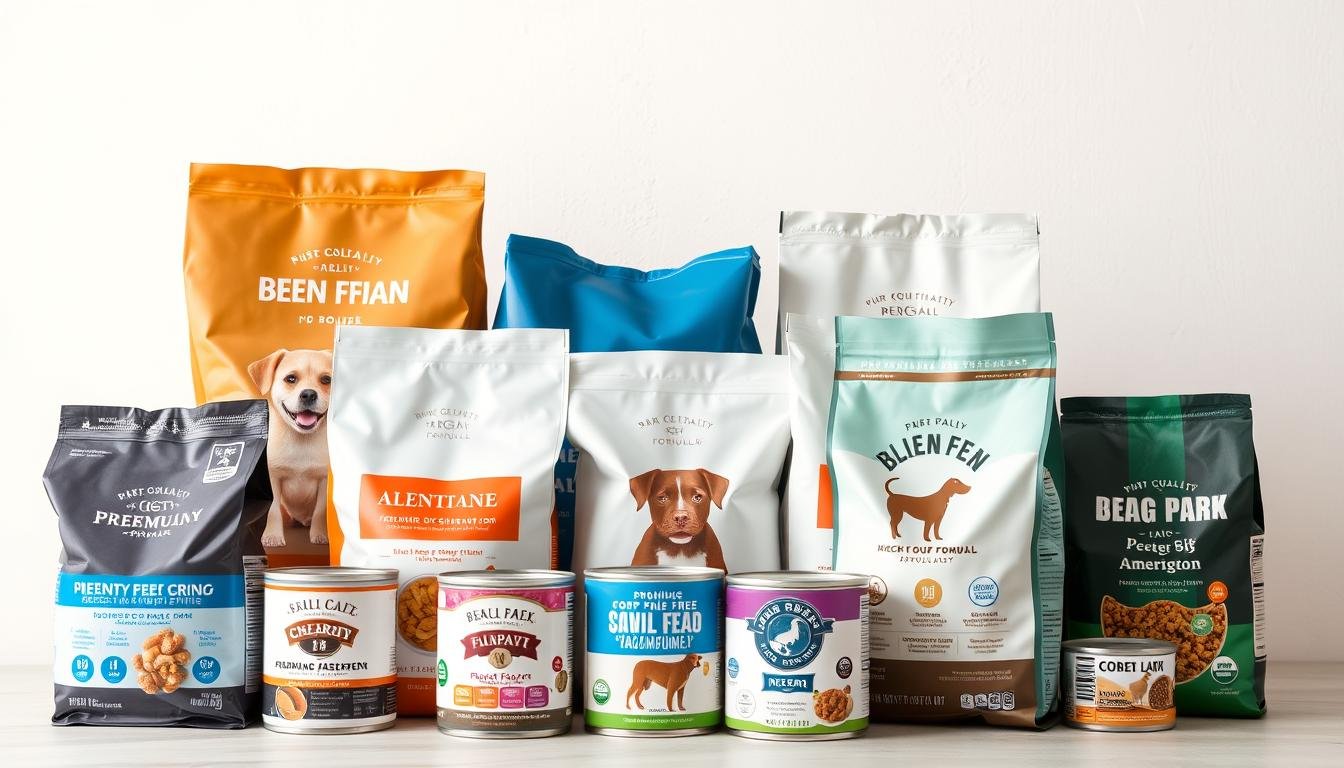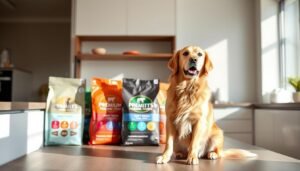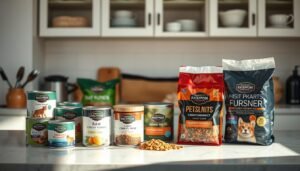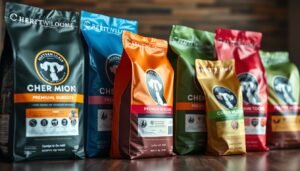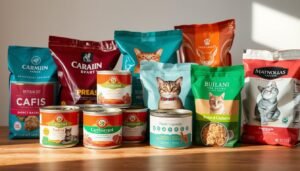Watching my dog feel uncomfortable was really worrying. She started scratching a lot and got hot spots. I took her to the vet and found out she had allergies.
Then, I had to find the best dog food for her allergies. There were many options, but I didn’t know which one was right. I tried different foods and learned what to look for.
I found out that quality ingredients are key. I’m excited to share what I learned with other dog owners facing the same issues.
Key Takeaways
- Identifying allergens is key for your dog’s health.
- Quality ingredients are very important in dog food.
- Hypoallergenic dog food can help with allergies.
- Limited ingredient diets might help allergy-prone pets.
- Watching how your dog reacts to new food is vital.
Understanding Dog Allergies: Signs and Symptoms
As a dog owner, knowing the signs of allergies in dogs is key. Allergies can show up in many ways. Spotting these symptoms early can greatly improve a dog’s life.
Many dogs face allergies from things in their environment. These can cause discomfort and health problems.
Common Allergens for Dogs
Dogs can be sensitive to many things. Common environmental allergens include:
- Pollen
- Dust mites
- Grass
- Fleas
Some dogs also react to certain foods like beef, chicken, and dairy. Finding out what allergens affect a dog is important.
How Allergies Affect My Dog
Signs of allergies in dogs can be itchy skin, stomach problems, or ear issues. For example, a dog might scratch a lot, have red skin patches, or inflamed ears. Watching for these signs helps me know if my dog has allergies.
When to Consult a Veterinarian
If my dog’s symptoms don’t go away or get worse, I need to see a vet. Vets can do tests to find out what’s causing the allergies. They can then help create a plan to make my dog feel better.
The Importance of Choosing Good Dog Food
It’s very important to make sure my dog eats the right food, even more so when they have allergies. Finding the right dog food for allergies is not just a choice, it’s a must for their health. Knowing what nutrients they need helps us pick the best food for them.
Nutritional Needs of Allergic Dogs
Allergic dogs need a special diet that’s balanced. They need proteins, fats, and carbs to keep their immune system and skin healthy. The best dog food is made with easy-to-digest proteins and no fillers that can make them sick.
Many dog foods are now made to help dogs with allergies. They have special ingredients that help their bodies stay healthy.
The Role of Quality Ingredients
The ingredients in dog food are very important. Good dog food for allergies uses new proteins and special grains that don’t make dogs sick. It also has vitamins and minerals from whole foods to help their skin and digestion.
Choosing a brand that tells you what’s in their food is key. It helps keep my dog happy and healthy.
How Food Allergies Differ from Other Allergies
It’s important to know the difference between food allergies and other allergies. Food allergies need special diets and might need a vet’s prescription. Environmental allergies might get better with the right dog food.
Top Ingredients to Look for in Allergy-Friendly Dog Food
Finding the right ingredients for allergy-friendly dog food is key for my furry friend’s health. The right mix can greatly help manage allergies and sensitivities. Here are some important ingredients to consider.
Novel Proteins that Work
Looking for allergy-friendly dog food? Try using novel proteins like venison and duck. These are not as common in dog food, which lowers allergy risks. I’ve seen my dog’s health and happiness improve with these proteins.
Hypoallergenic Grain Options
Choosing hypoallergenic grains is also vital. Sweet potato and oatmeal are great because they’re easy to digest and less likely to cause allergies. They give my dog the carbs she needs without upsetting her stomach.
Beneficial Additives for Allergies
Quality proteins and grains are just the start. Omega fatty acids and probiotics are also key. Omega fatty acids help with skin health, which is important for dogs with allergies. Probiotics help with digestion, making my dog’s diet more complete. Adding these to her food has made a big difference in her health.
My Experience with Grain-Free Dog Food
Switching to grain-free dog food helped my dog a lot. Many owners choose this diet to fight allergies and improve their dog’s skin and coat. I saw big benefits and wanted to learn more about it.
Potential Benefits for Allergies
Grain-free diets might help with allergies. They can make dogs less itchy and upset in their stomachs. My dog’s fur got shinier and healthier. They also had fewer tummy troubles, showing grain-free diets are good for some dogs.
Common Misconceptions about Grain-Free
Many people think grain-free is always better for dogs. But it’s not true for every dog. It’s important to think about what each dog needs. Talking to a vet can help find the right food.
Recommended Brands I’ve Tried
I tried many grain-free dog foods and found some great brands. Taste of the Wild, Blue Buffalo, and Merrick are top picks. They have different flavors and proteins to meet each dog’s needs.
Reviewing Limited Ingredient Diets
Limited ingredient diets (LIDs) are made for dogs with allergies or sensitivities. They have fewer ingredients to find out what causes allergies. This makes feeding easier for dogs and their owners.
What Are Limited Ingredient Diets?
LIDs have fewer ingredients than regular dog food. This cuts down on ingredients that can cause allergies. They use simple protein and carbs to make the diet easier.
Benefits I’ve Noticed with My Dog
My dog’s skin and digestion got better on a limited diet. They have less gas and bloating. This makes them and me feel better.
The simple ingredients are easy to watch for reactions. This makes my dog more comfortable and happy.
Popular Limited Ingredient Brands
Many brands are good for dogs with allergies. They offer quality food with fewer allergens.
| Brand | Key Features | Flavor Options |
|---|---|---|
| Canidae | Real meat as the first ingredient, grain-free options | Chicken, Lamb, Salmon |
| Blue Buffalo | Natural ingredients, no poultry by-products | Duck, Fish, Pea |
| Wellness | Limited ingredient focus, grain-free, high protein | Turkey, Venison |
| Natural Balance | Promotes healthy skin and coat, no artificial flavors | Sweet Potato & Fish, Duck & Potato |
High-Quality Protein Sources for Allergic Dogs
Choosing the right protein for dogs with allergies is key. Good protein helps keep dogs healthy, even if they’re allergic. It helps avoid bad reactions and keeps them feeling good.
The Impact of Protein Quality on Allergies
For dogs with allergies, protein quality matters a lot. Better protein sources cause fewer problems. They’re easier to digest and have amino acids that help the immune system.
Choosing top-notch protein can make a big difference. It helps dogs feel better and have fewer allergy attacks.
My Favorite Protein Sources to Consider
I’ve found some great protein sources for my dog’s allergies:
- Fish: Fish is full of omega fatty acids. It keeps the coat and skin healthy and provides good protein.
- Rabbit: Rabbit is a new protein that’s often safe for dogs with allergies.
- Turkey: Turkey is lean and full of nutrients. It’s a high-quality protein that dogs like.
- Pea Protein: Pea protein is a plant-based option. It’s easy to digest and safe for many dogs.
| Protein Source | Benefits | Allergy-Friendliness |
|---|---|---|
| Fish | High in omega fatty acids, supports skin health | Generally well-tolerated |
| Rabbit | Low in fat, easily digestible | Hypoallergenic |
| Turkey | Lean protein, rich in nutrients | Lower allergenic |
| Pea Protein | Rich in plant-based protein, promotes digestive health | Usually allergy-friendly |
The Benefits of Topical Supplements
Topical supplements are great for dogs with allergies. They make my dog’s life better. They also help with health problems linked to allergies.
Omega Fatty Acids and Skin Health
Omega fatty acids are good for a dog’s skin. They cut down on inflammation and itching. This makes them key for fighting allergies.
My dog’s coat and skin got better. They stayed shiny and soft. Omega fatty acids also make the skin stronger against allergens.
My Experience with Probiotics
I started using probiotics for my dog’s allergies. They help with digestion and boost the immune system. My dog felt better and was more energetic.
I think probiotics are a good choice for allergy management. You should try them and see the difference.
Other Helpful Supplements
There are more supplements for dogs with allergies. Quercetin and turmeric are two examples. They help with inflammation and boost the immune system.
These supplements helped my dog a lot. They made managing allergies easier for him.
| Supplement | Benefits |
|---|---|
| Omega Fatty Acids | Enhances skin health and reduces inflammation |
| Probiotics | Improves gut health and boosts immune function |
| Quercetin | Offers antioxidant benefits and reduces allergy symptoms |
| Turmeric | Supports immune health and brings anti-inflammatory effects |
Budget-Friendly Options for Allergy-Friendly Dog Food
Finding good dog food for allergies can be hard, but it doesn’t have to be expensive. There are affordable options that are also high quality. Making your own dog food can also save money and keep your pet healthy. I’ll share how to find cheap dog food that’s good for your dog.
How to Find Quality Food on a Budget
Looking for cheaper food? Compare what’s in it and how it’s made. Use online tools to help. Buying a lot or subscribing can save you money. Look for brands that are not as popular but use good ingredients.
Homemade Dog Food Recipes to Try
Making dog food at home is fun and can save you money. Use simple things you have to make tasty meals. Here are two easy recipes for dogs with allergies:
- Chicken and Rice: Cook chicken and mix it with brown rice and carrots. It’s easy on their stomachs and full of nutrients.
- Beef and Sweet Potato: Cook ground beef and mix it with sweet potatoes and green beans. It’s a great way to add nutrients.
Affordable Brands I’ve Found
I’ve found some affordable dog food brands that are good for allergies. Nutro and Blue Buffalo have cheaper lines but keep the quality up. Also, local stores often have their own brands that are a good deal without losing nutrition.
Brands to Avoid When Your Dog Has Allergies
As a dog owner, I know not all dog food is good. Some brands are bad for dogs with allergies. Knowing which brands to avoid helps keep our pets healthy.
Why Certain Ingredients Are Problematic
It’s important to know what’s in dog food. Fillers like corn and soy can make dogs sick. They can also make allergies worse. Always check the labels for artificial stuff that might harm your dog.
Personal Disappointments with Certain Brands
I’ve tried many dog foods, but some were bad. Brands like Pedigree and Iams had corn and by-products. My dog didn’t like them, so I stopped using them. Talking to other pet owners can help find better food.
Transitioning to New Dog Food Safely
Changing dog food needs to be done carefully, for dogs with allergies or sensitive stomachs. I use a special method to help my dog get used to the new food. This way, they can adjust slowly and avoid stomach problems.
How to Transition Without Upsetting My Dog’s Stomach
The transition takes 5 to 7 days. I start by mixing a little of the new food with their old food. On Day 1, it’s 25% new and 75% old.
By Day 3, it’s 50-50. Then, on Day 5, it’s 75% new and 25% old. By Day 7, they’re eating only the new food. Some dogs might need more time, like those with sensitivities or stomach issues.
Tips I’ve Learned for a Smooth Switch
I’ve learned a few important tips for switching dog food. Watching my dog closely is key. I look for signs like vomiting, changes in appetite, or diarrhea.
If I see any bad signs, I slow down the change. I adjust based on how my dog is doing. For more help, I check out this resource.
Monitoring My Dog’s Reaction to New Food
When I introduce new food, I watch my dog closely. This helps me see how they react to the new diet. I look for signs that show they’re getting better with their allergies.
Signs of Improvement to Look For
I look for certain signs that my dog is feeling better. These signs help me know if the new food is working. Here are some important ones:
- Less itching: If my dog scratches less, it means the new food is helping.
- Improved coat quality: A shiny coat means my dog is healthier.
- Stable gastrointestinal health: Normal poop means the new food is okay for them.
- Increased energy levels: A happy, energetic dog is a sign of good health.
When to Give up on a Specific Food
Not every food is right for my dog. Knowing when to stop trying a food is important. If the new food doesn’t help and my dog’s symptoms get worse, it’s time to try something else.
Conclusion: Finding the Right Food for My Allergy-Prone Dog
Choosing the right food for my allergy-prone dog is very important. It’s not just a step. It’s a big process that meets my dog’s special needs. I learned about common allergens and picked allergy-friendly ingredients.
Exploring limited ingredient diets and high-quality proteins helped a lot. Every choice I make affects my dog’s health and happiness.
Recap of My Key Takeaways
Finding the right food changed my dog’s life for the better. I learned to choose novel protein sources and watch for reactions when trying new foods. Always check the ingredient labels carefully.
Talking to other dog owners helped me a lot. It showed me we’re all in this together.
Encouragement for Fellow Dog Owners
If your dog has food allergies, you’re not alone. Finding the right food can be hard, but it’s doable. Be patient and keep researching.
What works for one dog might not work for another. Keep looking until you find the perfect food. Together, we can make sure our dogs are happy and healthy.

